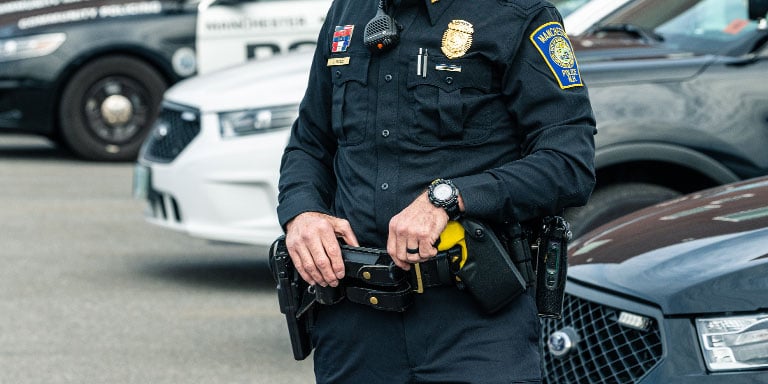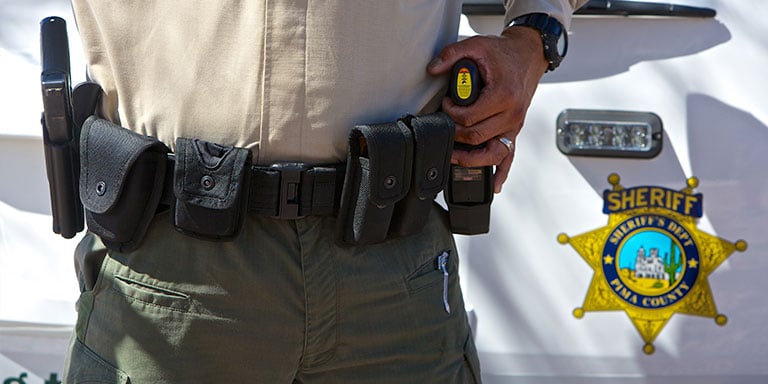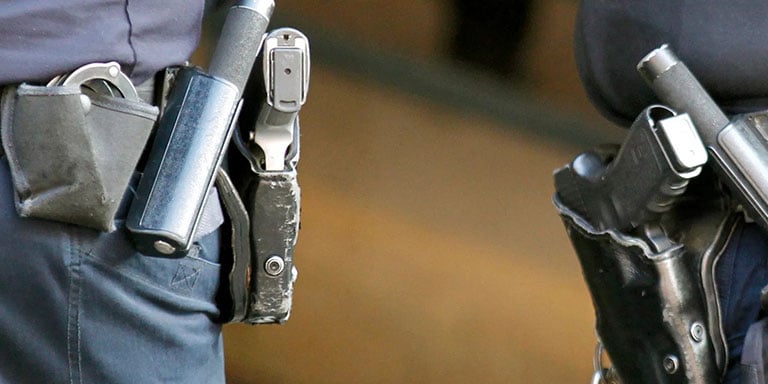How To Set Up Duty Belt

Most police academies provide recommendations on setting up a duty chugalug. However, organizing your belt is an ongoing trial-and-error procedure. Many times, you can tell the years an officeholder has been on the street by how they clothing their duty gear and what they choose to deport.
- How to Position Your Duty Belt
- Essential Backup Equipment
- Testing out Your Duty Chugalug
- How to Cull Your Equipment
How to Position Your Duty Chugalug

Positioning your belt is a process. No two officers are akin — we come up in all sizes and shapes. The key is a balance betwixt functionality and comfort. Functionality refers to the ease of drawing or accessing equipment y'all need under stressful situations. When wrestling with a suspect, y'all need to pull your handcuffs in one rapid motion without a lot of idea.
Condolement is an equally important consideration. When you're riding in a patrol car for extended periods, if something is digging into your back, information technology won't terminal long there. Yous'll likely have to motion it and replace it with something else.
Proper remainder is besides important. Wearing ten or more than pounds of gear on your duty belt will touch your posture and lower back over time. To lessen this effect, evenly distribute heavier items on your belt. Kickoff with the proper placement of the sidearm. This volition be on the officeholder's hip on their strong side. Items of roughly equal weight, similar your portable radio and expandable baton, are placed on the weak / support side.
A magazine-pouch and pepper spray should be toward the front of the belt on the weak side. The officer'southward handcuffs, which are often carried apartment against the lower back, weigh these. Two unmarried cuff cases work well in this location. A double-stack cuff example may need to exist relocated to the forepart of the officer's belt.
Essential Backup Equipment

Several disregarded items should be considered for your duty belt. For case, a handcuff primal concealed somewhere on the back of your belt. Endeavour putting a cardinal inside a chugalug keeper and then forget near it until it'south needed. A worst-example scenario would involve existence disarmed and handcuffed in a hostage situation. That hidden key could be a lifesaver. Information technology'south likewise a handy backup to uncuff someone when you don't have your regular key. Shop Duty Accessories
Another essential is a backup flashlight. Every officer carries a bright light, peculiarly on the night shift, only flashlights accept a mode of failing at the worst possible time. Consider your light failing during a foot chase of an armed robber through a swampy forest on a pitch-black dark. Getting the pic? A pocket-size backup flashlight on an officer'due south belt is essential.
Store Tactical Flashlights | Learn more about how to choose a tactical flashlight.
Testing out Your Duty Belt

It's of import to vesture your total duty chugalug to the range during each pistol qualification. You demand to practice drawing your firearm and reloading from the duty chugalug. Officers should never be pulling magazines from anywhere except where they regularly carry them. These learned motor skills get automatic and so you don't have to look or even recall about where to reach for a fresh magazine. Both expandable batons and pepper spray should also be fatigued with that aforementioned automatic muscle memory.
Now you've ready your belt, positioning equipment to exist comfortable, functional and weight balanced, you lot're done, right? Not and so fast — and that's meant literally. While however on the pistol range wearing your full duty gear, it's at present time to run across how you part wearing your equipment.
Showtime, take a warm up jog while at the range. Officers should be aware how well the gear remains secured to the body. Once warmed up, complete several full speed forty-g dashes — the kind of activeness you tin expect during a human foot chase. How does your duty gear react? Do all items stay secure, or do they flop around? Or worse, do they dislodge and drop from your belt? It happens. Make the necessary adjustments so your equipment moves with you and doesn't impede your speed.
You should complete one terminal exam, a test many officers are asked to complete at pre-raid briefings. Hop up and down several times. Hear anything? Stealth is essential in the everyday life of a patrol officeholder. A silent arroyo when reacting to a crime in progress or when clearing a residence is vital. Keys and fundamental holders are major offenders, but they don't have to exist. Go along a wide rubber ring handy and wrap it around your keys — no more jingle-jangle, problem solved.
Earlier selecting optional duty gear, it's essential to know your department's rules and regulations. While some departments used to mandate nigh all issued equipment, most have become less stringent over fourth dimension. Today's officeholder wants to acquit the highest quality gear they tin can purchase, as their lives may depend on it. Shop Duty Carriers
How to Cull Your Equipment
Duty Belts

To choose a duty belt, y'all must outset decide how you lot will habiliment it. At that place are three basic approaches. The erstwhile school method is to carefully thread the duty belt through each slice of equipment and and so the respective trouser belt loop so all the gear ends up in the proper location. It gives a very neat appearance, peculiarly on lean officers. The downside is that it takes quite a chip of time to thread each item onto the belt. It besides takes a lot of fourth dimension to remove the chugalug from the uniform pants.
A significant improvement on this trouble is the belt keeper system. The officer wears an inner leather belt through the trouser belt loops. They then affix an outer duty belt to the inner belt with a series of snap or Velcro chugalug keepers. Usually half dozen or more keepers concur a duty chugalug in identify. The most meaning advantage of the keeper system is that once you unsnap the keepers, the entire duty belt comes off in 1 piece with all the equipment. It makes getting in and out of uniform much quicker. Shop Duty Belt Keepers
The 3rd option is a Velcro double-chugalug system. The inner belt is covered in Velcro. Velcro also covers the under-side of the outer duty belt, and the two stick tightly together. In less than a minute, yous tin put on or take off a fully loaded belt. There's even belts that have pocket-size cushioning pillows, which are great for the lower back.
The adjacent consideration is the material. Virtually departments will have a preference. Nylon is much lighter and gives more of a tactical advent. Leather is nonetheless very popular, and nothing says "squared away" similar a highly polished set of duty gear. Form-A uniforms should always be accompanied past highly polished leather. The class-B compatible is generally a tactical work uniform and a improve fit for nylon gear. Shop Duty Belts
Duty Holsters

Most departments issue duty weapons and holsters. However, with gun-mounted tactical flashlights and lasers, personally endemic specialized holsters are common. A laser on a handgun is an essential police force tool. During night fire qualification, some officers find it's easy to shoot the entire course from the hip with laser-guided accurateness. Well-nigh departments let these tactical add-ons, but they also set a minimum standard for the alternate holster.
Duty holsters are designated equally retention level 1, level 2, or level three. The levels betoken the number of actions necessary to remove the weapon from the holster. Level 3 holsters have the most prophylactic features and require the officer to accept several actions to depict the weapon. With practice, these movements become 2nd nature to a well-trained officer. Most compatible patrol officers are required to carry a level three. A level two holster usually finds a home with detectives and other plainclothes assignments. The level i holster is most practical for off-duty concealed carry applications.
Shop Duty Holsters | Learn More than about How to Cull a Gun Holster
Tasers

Officers are encouraged to habiliment their sidearm on their dominant side. As a result, tasers are usually worn on the weak side, either necessitating a cross describe or requiring officers to describe their taser with their non-dominant mitt. The easiest method, though, is only to think that you should draw your firearm from your dominant side, and you should describe your taser from your weak side.
More uncommonly (but not unheard of), police may go on their taser in a drop leg holster or on a holster attached to a vest; information technology but depends on the uniform requirements of the job. Whatsoever the example, cartoon your taser, like every other item on your duty belt, should become muscle retentiveness.
Shop Taser Holsters
Handcuffs

When it comes to handcuffs, y'all have 2 choices: hinged cuffs, which are attached past a hinge, or chain cuffs, which are attached by a few links of concatenation. Each has its advantages and disadvantages, but there is room for both on every officer's chugalug. Nigh officers carry two sets of cuffs for a couple of reasons. Consider the most obvious reason: responding to a fight call, you arrive first and break up a mutual fight, absorbing both combatants. However, you only take one set of cuffs. You lot'll probably cease upwardly securing i person in the dorsum of your patrol unit uncuffed while handcuffing the other.
There are also situations where a person, because of their size, an injury or inflexibility, may crave two sets of cuffs hooked together to secure them. Hinged cuffs have tactical applications. With one cuff secured, a resisting suspect tin can exist taken to the footing with an arm drag. The inflexibility of the hinge makes this possible. On the other finish of the spectrum, you lot might find yourself in a situation where you lot pull over a senior citizen with a traffic warrant. Departmental policy requires you to handcuff all persons under arrest. In this state of affairs, less restrictive concatenation cuffs might exist more appropriate.
Officers should always properly maintain their handcuffs. Proceed the locking mechanism lightly oiled and work the activeness regularly so they open up and close smoothly. Engrave your badge number on them so you can later identify your cuffs before they mysteriously disappear. Shop Handcuffs
You as well need a proper handcuff key, non the piffling ones that come with nigh cuffs. Most officers carry a cardinal about the size and shape of a pen, allowing for easier double-locking and unlocking. Many officers carry these clipped inside their shirt pockets. Larn more nearly how to apply police force handcuffs
Other Essential Equipment

Handcuff cases come up in many sizes and shapes. The most crucial bespeak hither is your ability to admission your cuffs apace. Cases can exist either completely closed or partially open. The closed cases require you to pull upwards on a flap, unsnapping the cover before pulling out the cuffs. Open cases tend to be thinner and require only the action of pulling the cuffs out of the holder, making them a bit faster to deploy. Deciding on a example comes downward to personal preference, forth with trial and mistake. Shop Duty Cases
Pepper spray, when properly applied, is a valuable tool. Information technology is very useful and is ordinarily kept on the front of the chugalug where it tin can be quickly deployed. Brand sure the spray button cannot make contact with anything else on your belt. The only affair worse than having your pepper spray accidentally discharge in your patrol motorcar is taking your unit out of service and explaining the error to your sergeant.
Most officers bear an expandable baton. What started out as the nightstick evolved to the side handle billy, and is now the expandable baton. It'south mutual to bear it on your weak or back up side, virtually just not touching the radio. This helps to weigh the weight of the sidearm. The expandable baton is constructive in crowd command situations. Only pulling the baton and forcefully expanding it causes a sharp snapping noise which has a similar result to racking the action of a shotgun: people hear the noise and understand the officer is serious. To that extent, it's very constructive. Shop Batons
Magazine pouches and extra magazines are almost universally located somewhere on the front end of the duty belt. An officer should be able to keep their eyes on a threat while removing a new magazine from the pouch and reloading. Depending on the capacity of the sidearm, two fully loaded magazines in the pouch is typically the right balance between the added weight and not running out of ammunition. Many officers keep additional loaded magazines in their patrol-bag in the front seat of their vehicle. Shop Mag Pouches
Organizing your duty chugalug is not an verbal science. Officers are congenital differently, move differently and accept different duties that may touch on the way they gear up their chugalug. While there are full general guidelines and certain methods that are common, information technology's up to each private to decide how best to prepare their belt. The more y'all exercise with your equipment and the more time you spend on the job, the better you'll empathize which techniques work best for you. What matters nigh is that your duty belt configuration is efficient, comfy and allows you to do your job to the best of your ability.
Did you notice this article helpful?
Source: https://tacticalgear.com/experts/how-to-set-up-a-police-duty-belt

0 Response to "How To Set Up Duty Belt"
Post a Comment